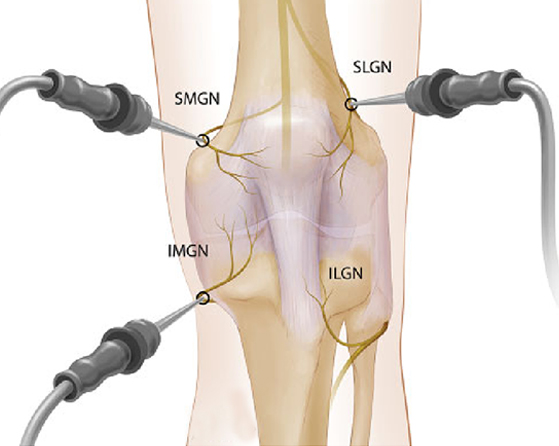Introduction
Knee osteoarthritis can be debilitating, affecting millions worldwide. Traditional treatment options may fall short in providing sustainable pain relief. Enter radiofrequency ablation (RFA) of genicular nerves – an innovative technique that has gained momentum for its potential to alleviate pain and enhance the quality of life for individuals with knee osteoarthritis. In this blog, we will delve into the mechanics behind thermal rhizotomy of genicular nerves, explore standard versus cooled radiofrequency ablation, detail the technique, discuss clinical outcomes, and shed light on how Alleviate Pain Clinic combines this approach with other modalities.
Mechanism of Action of Thermal Rhizotomy of Genicular Nerves
Radiofrequency ablation involves the application of targeted heat to nerves responsible for transmitting pain signals. In the case of knee osteoarthritis, genicular nerves play a significant role in pain perception. By using radiofrequency energy to disrupt the function of these nerves, the transmission of pain signals from the knee joint to the brain is reduced, leading to pain relief.
Standard vs Cooled Radiofrequency Ablation
There are two main types of RFA for genicular nerves: standard and cooled. Standard RFA uses heat to create a lesion on the nerve, effectively disrupting its function. On the other hand, cooled RFA employs a specialized technology that allows for the controlled cooling of the electrode, preventing excess tissue damage and improving the precision of the procedure. Some studies show Cooled RFA i to provide longer-lasting pain relief compared to standard RFA. (2) whereas some studies don’t see any statistical difference in treatment outcomes. In our experience at ALLEVIATE of using both the modalities, we observed similar levels of pain relief and improvement in function.
Technique of Radiofrequency Ablation for Genicular Nerves
The procedure involves inserting a thin needle with an electrode tip near the targeted genicular nerves under imaging guidance. Once the needle is positioned correctly, radiofrequency energy is transmitted through the electrode, creating a controlled lesion on the nerve. This disrupts its ability to transmit pain signals, leading to pain relief. The technique is minimally invasive and usually performed on an outpatient basis.
Clinical Results
Numerous studies have shown promising results regarding the effectiveness of radiofrequency ablation of genicular nerves in relieving knee osteoarthritis pain. Patients who undergo this procedure often experience a significant reduction in pain intensity, improved mobility, and enhanced overall quality of life. Clinical outcomes have been positive both in the short term and, in many cases, over an extended period.
Combining Approaches at Alleviate Pain Clinic
At Alleviate Pain Clinic, we understand that every patient’s pain profile is unique. Hence, we adopt a holistic approach to pain management. While radiofrequency ablation of genicular nerves is a potent tool in alleviating knee osteoarthritis pain, we often combine it with other modalities such as physical therapy, regenerative treatments, and personalized pain management plans. This comprehensive approach ensures the best possible outcome for each individual.
Conclusion
Radiofrequency ablation of genicular nerves presents a groundbreaking solution for individuals suffering from knee osteoarthritis. By disrupting pain signal transmission, this technique can provide effective and long-lasting pain relief. Cooled RFA, precision techniques, and positive clinical outcomes make this procedure a beacon of hope for those seeking an alternative to traditional treatments. Alleviate Pain Clinic’s commitment to combining modalities further enhances the potential for lasting relief and improved quality of life.
References
- RFA of Genicular Nerves for Knee Osteoarthritis. https://www.ncbi.nlm.nih.gov/pmc/articles/PMC6192137/
- Cooled Radiofrequency Ablation for Knee Osteoarthritis Pain. https://www.ncbi.nlm.nih.gov/pmc/articles/PMC6329020/ Radiofrequency Ablation for Knee Osteoarthritis Pain. https://pubmed.ncbi.nlm.nih.gov/26927787/
- Effectiveness of Radiofrequency Ablation for Knee Osteoarthritis. https://www.ncbi.nlm.nih.gov/pmc/articles/PMC5694665/





